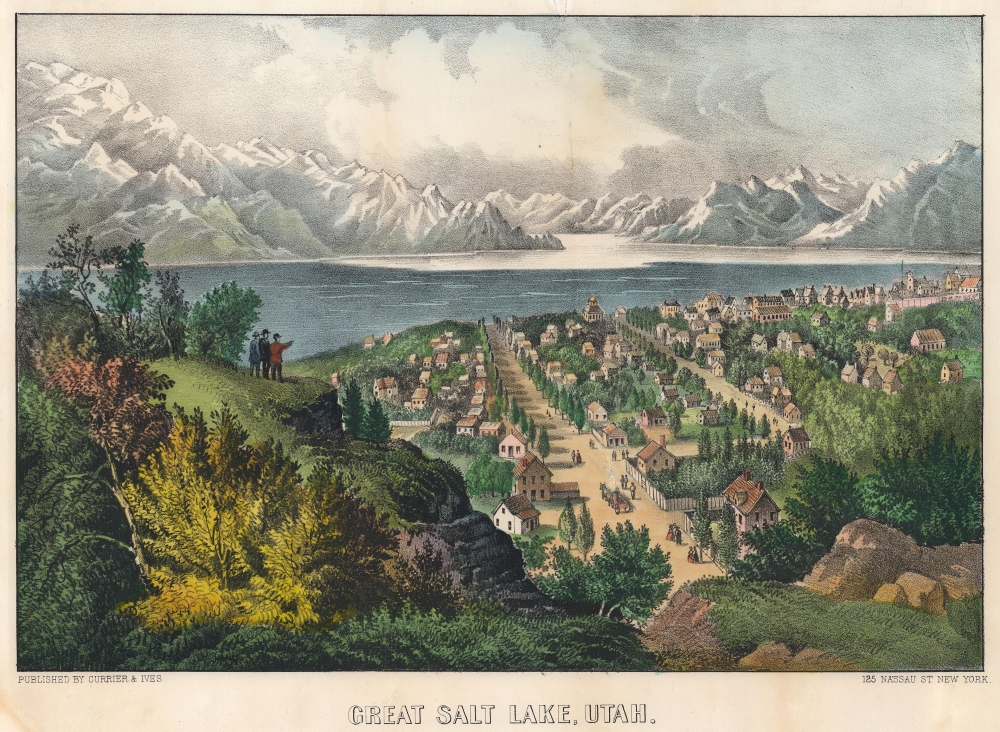This item has been sold, but you can get on the Waitlist to be notified if another example becomes available, or purchase a digital scan.
1870 Currier and Ives Lithograph View of Salt Lake City, Utah
GreatSaltLake-currierives-1870
Title
1870 (undated) 9.125 x 12.375 in (23.1775 x 31.4325 cm)
Description
A Closer Look
The view looks westward on Salt Lake City from a rocky outcropping above and behind. Great Salt Lake and the dramatic Wasatch Range dominates the background. Salt Lake City fills the midground with broad tree-lined avenues, houses, and other buildings. The Tabernacle is nowhere in evidence, suggesting that the base art for this view predates its construction. In the foreground, rugged forested hills overlook the city, giving it an idyllic Switzerland-like energy. The Great Salt Lake stretches toward the horizon, with the Wasatch Range rising majestically in the background.Historical Context
In the 1870s, Salt Lake City, nestled in the vast expanse of the Utah Territory, stood as a beacon of faith, industry, and resilience. Founded by Mormon pioneers seeking religious freedom, the city flourished as the spiritual and administrative center of The Church of Jesus Christ of Latter-day Saints. Beyond its religious significance, the city buzzed with activity, boasting a growing economy fueled by mining, agriculture, and trade. As settlers from diverse backgrounds flocked to the region, Salt Lake City became a vibrant melting pot of cultures, fostering innovation and progress amidst the challenges of frontier life. The 1870s marked a pivotal period in the city's history, as it emerged as a dynamic hub of faith, enterprise, and cultural exchange in the American West.Publication History and Census
This view was created and published by Currier and Ives c. 1870. We note two cataloged examples: New York Public Library and the D'Amour Museum of Fine Arts in Springfield, Massachusetts.CartographerS
Nathaniel Currier (March 27, 1813 - November 20, 1888) was an American lithographer best known as part of 'Currier and Ives'. Born in Roxbury, Massachusetts, Currier attended public schools until fifteen, when he apprenticed with the Boston lithographic firm of William and John Pendleton. The Pendletons were the first successful lithographers in the United States and were responsible for educating the next generation of lithographic printers. In 1833, Currier left the Pendleton's shop to work with M.E.D. Brown in Philadelphia. A year later, Currier moved to New York City, where he planned to start a business with John Pendleton. When Pendleton backed out, Currier found a new partner, founding 'Currier and Stodart', but the concern survived for just a year. Currier opened his own lithographic studio in 1835 as an eponymous sole-proprietorship. He initially printed the standard materials, including letterheads, sheet music, and handbills. Later in 1835, Currier began issuing current event imagery. Some of his news printers were issued in the New York Sun. By 1840, Currier had moved away from 'job printing' and further toward fine-print publishing. His Awful Conflagration of the Steam Boat 'Lexington', was published in the Sun that year, as well as being separately issued. James Ives (March 5, 1824 - January 3, 1895) began working under Currier in 1850 as a bookkeeper. Ives contributed greatly to the growth of the business, particularly as a manager, marketer, and businessman. Ives became a full partner in 1857, and the firm was renamed 'Currier and Ives'. Currier and Ives produced over 7,500 images and is best remembered for its popular art prints, particularly Christmas scenes and landscapes. They also produced banners, illustrations of current events, views, and historical scenes. Currier retired in 1880 and turned the business over to his son Edward. Currier married Eliza West Farnsworth in 1840, with whom he had one child Edward West Currier. Eliza died in 1843. Currier remarried to Lura Ormsbee in 1847. Other than being a lithographer, Currier also served as a volunteer New York City fireman during the 1850s, and he liked fast horses. More by this mapmaker...
James Merritt Ives (March 5, 1824 - January 3, 1895) was an American businessman, bookkeeper, and lithographer who oversaw the business side of the famed lithographic firm Currier and Ives. Born in New York City, Ives was a self-trained artist who began working at the age of twelve. He married Caroline Clark (1827 - 1896) on June 24, 1846, who was the sister-in-law of Nathaniel Currier's brother, Charles Currier. In 1852, Nathaniel Currier (March 27, 1813 - November 20, 1888) hired Ives as the bookkeeper for his firm N. Currier, Lithographer, on Charles's recommendation. Ives' talent for art and his knowledge of the artistic world soon became apparent to Currier, who valued his insights as well as the business acumen. Currier offered Ives a full partnership in 1857. They renamed the firm 'Currier and Ives' with Ives as the general manager. Ives began to play a role in selecting artists and prints to publish, and was responsible for pursuing publication of scenes of middle-class America that made the firm famous. After Ives died in 1895, his sons continued to work with Currier's son to manage the firm until it was liquidated in 1907. Learn More...

